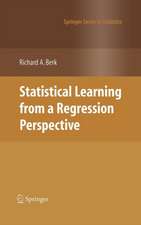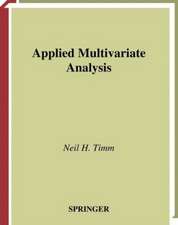Advances in Cross-National Comparison: A European Working Book for Demographic and Socio-Economic Variables
Editat de Jürgen H.P. Hoffmeyer-Zlotnik, Christof Wolfen Limba Engleză Hardback – 27 feb 2003
This book is mainly written for two groups. First, researchers and practitioners involved in comparative research in Europe. Second, researchers working with data of the statistical offices of European countries and data from institutions of the European Union.
| Toate formatele și edițiile | Preț | Express |
|---|---|---|
| Paperback (1) | 950.84 lei 6-8 săpt. | |
| Springer Us – 5 oct 2012 | 950.84 lei 6-8 săpt. | |
| Hardback (1) | 955.88 lei 6-8 săpt. | |
| Springer Us – 27 feb 2003 | 955.88 lei 6-8 săpt. |
Preț: 955.88 lei
Preț vechi: 1165.70 lei
-18% Nou
Puncte Express: 1434
Preț estimativ în valută:
182.93€ • 188.98$ • 152.24£
182.93€ • 188.98$ • 152.24£
Carte tipărită la comandă
Livrare economică 25 martie-08 aprilie
Preluare comenzi: 021 569.72.76
Specificații
ISBN-13: 9780306477317
ISBN-10: 0306477319
Pagini: 428
Ilustrații: IX, 413 p.
Dimensiuni: 155 x 235 x 28 mm
Greutate: 0.74 kg
Ediția:2003
Editura: Springer Us
Colecția Springer
Locul publicării:New York, NY, United States
ISBN-10: 0306477319
Pagini: 428
Ilustrații: IX, 413 p.
Dimensiuni: 155 x 235 x 28 mm
Greutate: 0.74 kg
Ediția:2003
Editura: Springer Us
Colecția Springer
Locul publicării:New York, NY, United States
Public țintă
ResearchDescriere
As the European Union grows together we are faced with an increasing number of European surveys and statistics that rely on national instruments or questionnaires. We lack valid instruments with functional equivalence that allow international comparative analysis. This problem is especially important in the case of demographic and socio-economic variables. The usual practice in comparative social research is to work with national questionnaires and classifications thereby making meaningful comparisons questionable. To overcome these problems this book offers rules of comparison, tested instruments and examples for the measurements of basic demographic and socio-economic variables.
The book consists of five parts and a concluding chapter. Part 1 covers general problems and presents solutions for the harmonisation of data from different national and/or cultural contexts. In the second part EUROSTAT and ESOMAR present their established standard instruments. Tested instruments each covering one variable (i.e. occupation, education) are presented in the third part. The fourth part again includes suggested tools for the harmonisation of single variables for which standardised instruments are not yet available (i.e. age, religion, ethnicity, household, family, income). The last part presents selected empirical analyses demonstrating the use and fruitfulness of instruments presented before.
This book is mainly written for two groups. First, researchers and practitioners involved in comparative research in Europe. Second, researchers working with data of the statistical offices of European countries and data from institutions of the European Union.
The book consists of five parts and a concluding chapter. Part 1 covers general problems and presents solutions for the harmonisation of data from different national and/or cultural contexts. In the second part EUROSTAT and ESOMAR present their established standard instruments. Tested instruments each covering one variable (i.e. occupation, education) are presented in the third part. The fourth part again includes suggested tools for the harmonisation of single variables for which standardised instruments are not yet available (i.e. age, religion, ethnicity, household, family, income). The last part presents selected empirical analyses demonstrating the use and fruitfulness of instruments presented before.
This book is mainly written for two groups. First, researchers and practitioners involved in comparative research in Europe. Second, researchers working with data of the statistical offices of European countries and data from institutions of the European Union.
Cuprins
1. Measuring Demographic and Socio-Economic Variables in Cross-National Research: An Overview; C. Wolf, J.H.P. Hoffmeyer-Zlotnik. Part I: Harmonising Demographic and Socio-Economic Variables: Objectives. 2. Harmonising Data in Official Statistics: Development, Procedures, and Data Quality; M. Ehling. 3. The ISSP and its Approach to Background Variables; M. Braun, R. Uher. 4. Harmonising Sampling Frames and Indicators in International Market Research: A German Perspective; M. Smid, D. Hess.Part II: International Standards for Demographic and Socio-Economic Variables. 5. Harmonisation of Socio-Economic Variables in EU Statistics; L. Mejer. Appendix: EU-SILC Materials from the Pilot Study in 2002; compiled by U. Warner, J.H.P. Hoffmeyer-Zlotnik. 6. The ESOMAR Standard Demographic Classification: A System of International Socio-Economic Classification of Respondents to Survey Research; ESOMAR. Part III: International Instruments for Selected Variables.7. International Classification of Status in Employment, ICSE-93; E. Hoffmann. 8. International Statistical Comparisons of Occupational and Social Structures: Problems, Possibilities and the Role of ISCO-88; E. Hoffmann. 9. Three Internationally Standardised Measures for Comparative Research on Occupational Status; H.B.G. Ganzeboom, D.J. Treiman. 10. International Standard Classification of Education, ISCED 1997; UNESCO. 11. The CASMIN Educational Classification in International Comparative Research; H. Brauns, S. Scherer, S. Steinmann. 12. The Classification of Education as a Sociological Background Characteristic; J.H.P. Hoffmeyer-Zlotnik. Part IV: Suggested Conventions for Selected Variables for Which Comparative Instruments Do Not Exist. 13. How to Measure Sex/Gender and Age; C. Wolf, J.H.P. Hoffmeyer-Zlotnik. 14. How to Measure Race and Ethnicity; J.H.P. Hoffmeyer-Zlotnik. 15. How to Measure Household and Family; W. Bien, H. Quellenberg. 16. How to Measure (New) Work Situations; B. Langfeldt. 17. How to Measure Income; U. Warner, J.H.P. Hoffmeyer-Zlotnik. Part V: Cross-Cultural Comparisons: Empirical Applications. 18. Using CASMIN: The Effect of Education on Wages in Britain and Germany; M. Brynin. 19. Education and Unemployment Risks among Market Entrants: A Comparison of France, the United Kingdom and West Germany; H. Brauns, M. Gangl, S. Scherer. 20. The Validity of Income Measurements in Comparative Perspective: Non-Responses and Biases; C. Holst.Part VI: Harmonising Demographic and Socio-Economic Variables: Synthesis. 21. Comparing Demographic and Socio-Economic Variables Across Nations: Synthesis and Recommendations; J.H.P. Hoffmeyer-Zlotnik, C. Wolf. Contributing Authors. Index.
Caracteristici
Includes supplementary material: sn.pub/extras












